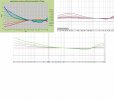After being first disappointed that the correction of my Yamaha is global and now others also showed some bad examples. I wanted to save Yamaha's reputation.The Yamaha variable loudness was well done.
The current crop of AS-xxx amplifiers are very disappointing
The newer Yamaha Aventage receivers (RX-A3080) have really nice loudness correction curves that get very close to the expected behavior - and sound good...
I attached a screenshot. The top left is based on (https://www.merlijnvanveen.nl/en/calculators/59-equal-loudness), who provide the reference corrections based on the iso loudness curves for 70 dB - you can also calculate them yourself based on the iso curve data. You can see that there is quite a lot going on also for the treble and there is a dip between 1K and 8K.
Top on the right is the result of YPAO Volume taken directly from the preout.
It matches up really nicely down to 100Hz. Above 12K, the iso curves should apparently not be followed. Thus Yamaha tapers them out at the last valid value.
In terms of comparison to the target curve, we first off see that the lower end is not raised correctly - it should be more linear. This is probably done because of the fear that it might strain the subwoofer or that, if used at night, you don't want to wake up everyone due to low frequencies wobbling through the house (someone even mentioned this a few posts above). The second deviation from the target curve is that 1K and 8K seem to be the points where the curves should meet. The 1K is close enough, 8K goes up a bit too early (ballpark of 0-2dB depending on how low your listening level is).
Nevertheless, these two mistakes can be easily corrected by using the PEQ of YPAO. I, on purpose, only used a single PEQ for the low end (I could use more here because the bass is already linearized by a MiniDSP, so all bands are available). At the top end it is not too crucial, as mentioned, the curves are pretty close. Nevertheless, one PEQ with small amplitude can produce a better linearity (the curves are almost linear between 8K-12K), and we can ensure the meeting point at 8K. The end points after adjustment with the PEQ end up nicely at their target level and the curves are very close. The result is below. Pretty nice actually!
When I listen to a movie, it is enough to choose the volume, then adjust the PEQ (it is simple - they can be kept in the same location, only gain (2 up) and Q (1 down) change per 5 dB).
It took me some time to figure out that the reference is 70dB and initially tried to match 85dB. I thought that it would be too low but the more I pondered about it, the more I feel like it might be a good tradeoff. For "hotter" mixes, it kicks in a bit late but then the compensation is also a bit stronger, which seems to work out well. For Netflix with its -27LUFS (and 79 reference) it seems to be a nice fit.
I am new on this forum but learned a lot in recent days - especially about mixing, which really helped me grasp what was going on.
Probably, what I am about to say is still only half correct...
But anyway a big thanks for all the input that I got in the last days.
If I understood correctly, when people master audio, they start by choosing the reference. I always thought that you target a different dB value, but it seems that most dial down their amp. This means if you mix for -20=79d, you dial down the amp to -6. Your software can then produce sounds at 0dB that are sent to the amp, translate to -6dB, and on a calibrated system, it produces 99 dB SPL.
Now comes the interesting part - the knowledge that the amp was set to -6 is completely lost in the end. Thus, if you now run the result on a calibrated system, the sound will actually be 6dB too hot - the actual reference setting would be -6dB.
You might not even notice the different reference level easily because Netflix targets -27LUFS with a reference of -20=79. LUFS measure loudness over time. Playing pink noise at -20dBA seem to lead to -21 LUFS over time. Following Netflix, you try to end up with a target of -27 LUFS. That is -26dBA for pink noise. Thus, on a calibrated system that leads to an increase of 6dB, the pink noise is again around -20dB, which is not far off of what you would see in a standard 85 cinema mix.
Let's come to our example for the loudness curve. You have mixed for 70dB. For a calibrated receiver, it means that loudness should kick in at the setting of exactly -15dB (for the reasons outlined above, on a calibrated system, the mix is played with 15dB too much).
Above the -15dB setting, the Yamaha does not apply loudness, below YPAO volume is activated (the flat line is -15dB).
What about souces that are mixed higher? You can use the "input trim" to shift the moment that YPAO volume becomes active upwards.
You don't have to go 15 dB to get a good correction - with +6dB, you are very close to the Netflix case. But even just leaving it as is without input trim does a great job.
I definitely enjoy listening with the compensation because I do admit that I have a tendency to listen a at lower volumes. Hope this rant helps a bit!
Attachments
Last edited:

